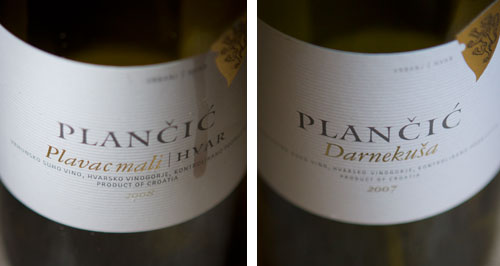
Plančić is a coastal Croatian winery on Hvar Island and when it comes to making truly Croatian wines, they know their business given that they only use native Croatian grapes. Bogdanuša, Parč, Darnekuša, and of course, Plavac Mali are all grapes that bless their vineyards. Is that being a hardcore Croat winemaker? You bet, and in Plančić’s case, it pays off a great deal in the end with an excellent series of wines, some of which are even grown on the ancient UNESCO World Heritage site of the Stari Grad Plain.
I came back from the Wine Gourmet Weekend in April with a couple of bottles. While neither was their mindbogglingly delicious Pharos Grand Cru (a bottle they were keeping under the table at the fair), they’re both a solid representation of the wines that they have on offer.
Plavac Mali 2008 is a take on the wine that weighs in at 13.8% alcohol and overall, it’s quite a potent glass. At the fair, it tasted true to what a Plavac should be. The body was full and drifted in to mint and licorice tones with a lingering acidity in to the finish. Once tasting it in a slower environ, other elements came out such as the fact that the nose definitely boasts the oak aging of the wine. It’s also more nuanced than I had picked up on in Zagreb as it’s more sandy with an undercurrent of fresh-cut carrot. A small touch of minerality comes up in the wine as well. A light plum comes in to the body as well with more decanting.
Something else that didn’t come up in Zagreb was that at the one hour mark of being open, the finish starts to fall off a bit and isn’t as robust as when first opened. It’s a minor element, but it was surprising to find given how well Plavac Mali enriches through long decanting.
Darnekuša 2007 was really, really interesting. I’m not just saying that because it’s a very rare native grape varietal only grown on Hvar. I’m also not just saying that because it’s hard to find due to it being a bit pissy about moisture and thus wineries don’t much like to grow it. I’m saying that it’s interesting because really and truly, it is. With 14.3% (that’s probably more like 15%) and 12 months in Slavonian oak, it immediately opens up with a spicy nose that has a touch of minerality to it. The body is peppery and herbaceous. It borders on being a touch green, but in a purposeful way that steps back long before it reaches that negative aspect in any way. Then there’s a touch of tar to the finish.
As it breathes, the body picks up a rhubarb aspect and that tar in the finish pokes its head in to the body a bit. The tannins in the body come up a good deal and then find their way in to the finish as well. Basically, it’s a constantly changing, rather wild wine. Probably not something I’d suggest for many food pairings except maybe grilled steak, but it makes for a mighty interesting glass to drink reminding me a bit of the natural wines people are making in Baix Empordà, Catalonia, Spain which are wild and a bit unpredictable in a similar way.
Needless to say, if you’re a fan of Croatian wines and you haven’t tasted Plančić, get on it. Or rather, get to Croatia as, if memory serves, they’re essentially not exported.
Read more about this and other wineries of Croatia’s southern region in our Dalmatia enotourism guide
